
POLAND Wolsztyn (Titan and Titania)
Re: POLAND Wolsztyn (Titan and Titania)
20:51:58 - noc... puste gniazdo:


Re: POLAND Wolsztyn (Titan and Titania)
poprzedni dzień 23.04.2025
następny dzień 25.04.2025
24 kwietnia
Witam wszystkich
Materiał:
- Tytan:
- Tytania:
❤ ("bocianienie"/mating):
________________________________________________
06:35:03 - poranek, gniazdo puste:
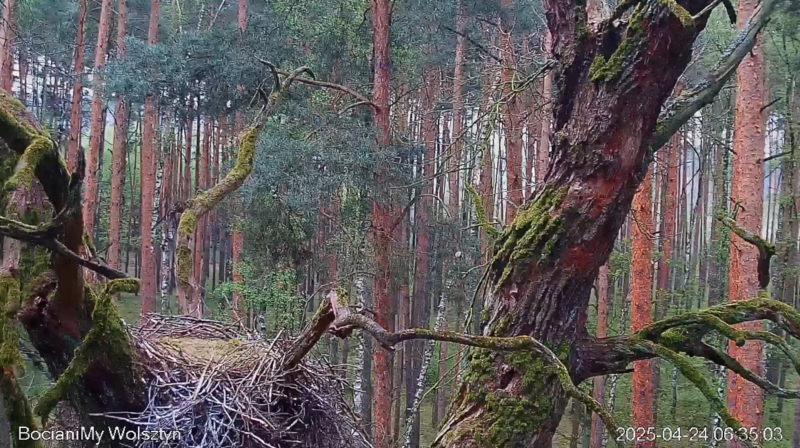
19:34:08 - wieczór, a bociana brak:
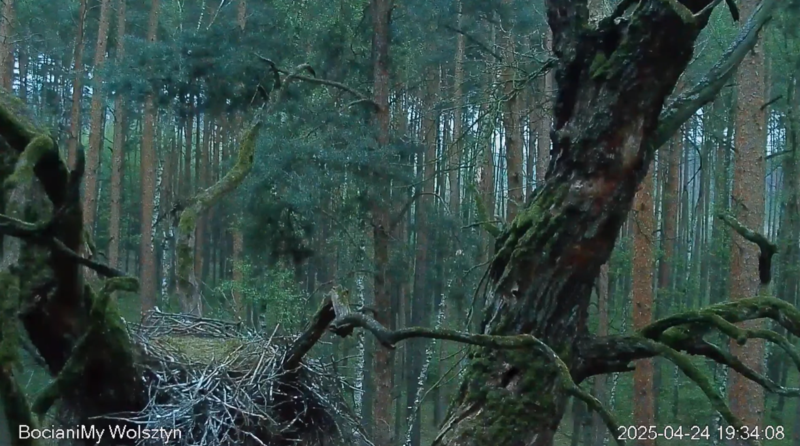
21:02:52 - i nocą gniazdo również puste:
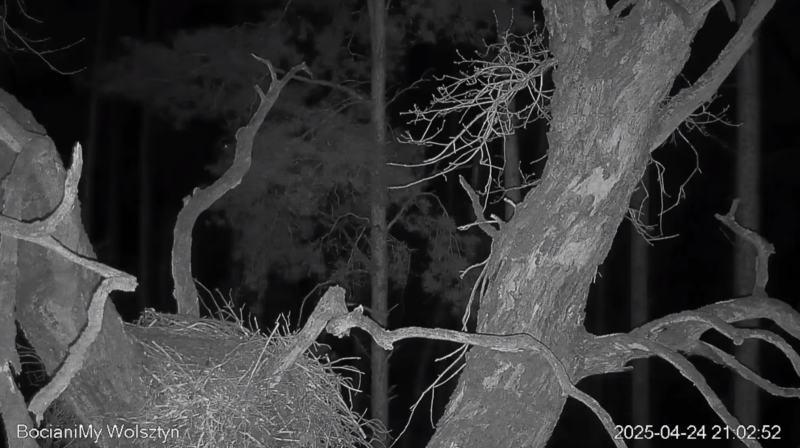
następny dzień 25.04.2025
24 kwietnia
Witam wszystkich
Materiał:
- Tytan:
- Tytania:
❤ ("bocianienie"/mating):
________________________________________________
06:35:03 - poranek, gniazdo puste:

19:34:08 - wieczór, a bociana brak:

21:02:52 - i nocą gniazdo również puste:

Re: POLAND Wolsztyn (Titan and Titania)
poprzedni dzień 24.04.2025
następny dzień 27.04.2025
25 kwietnia
Tego dnia nie pojawił się bocian. Gniazdo puste.
26 kwietnia
Witam wszystkich
11:22:36 - przylot bociana ze śpiewem (samiec, być może to Tytan):
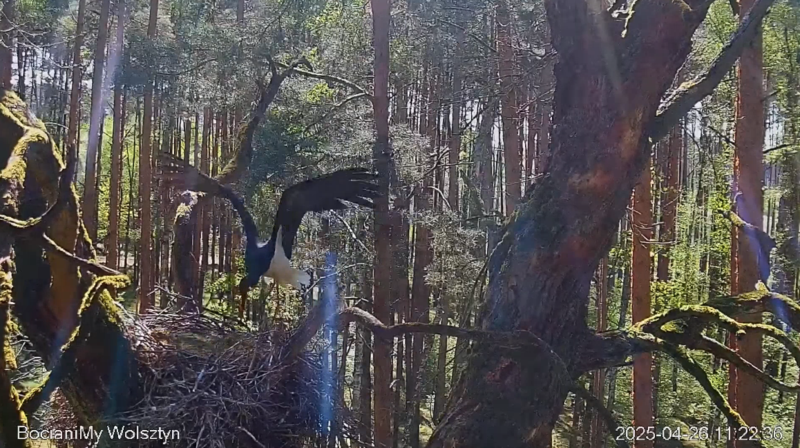
Chwilę odpoczął, poczyścił pióra, przegrzebał mech.
11:33:46 - rozejrzał się:
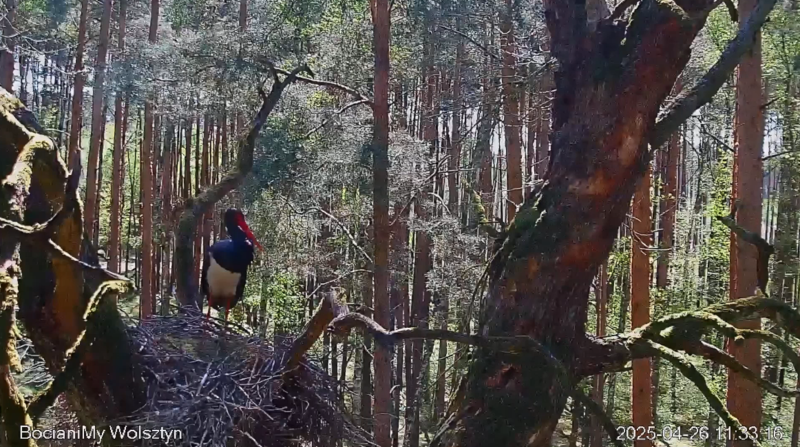
11:36:39 - ostatni kadr z bocianem, za chwilę musiał odlecieć (przeskok transmisji):
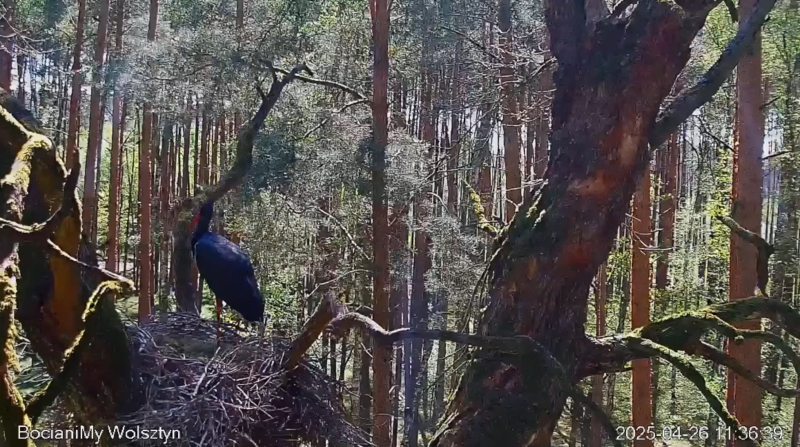
następny dzień 27.04.2025
25 kwietnia
Tego dnia nie pojawił się bocian. Gniazdo puste.
26 kwietnia
Witam wszystkich
11:22:36 - przylot bociana ze śpiewem (samiec, być może to Tytan):

Chwilę odpoczął, poczyścił pióra, przegrzebał mech.
11:33:46 - rozejrzał się:

11:36:39 - ostatni kadr z bocianem, za chwilę musiał odlecieć (przeskok transmisji):

-
marika.solo
- Site Admin
- Posts: 17976
- Joined: 29 Sep 2021, 09:38
Re: POLAND Wolsztyn (Titan and Titania)
April 29
Hello everyone
Uratowany przez leśników z Koła czarny bocian znów na wolności
wtorek, 29 kwietnia 2025
https://www.lodzkie.pl/strona-glowna/ak ... mYxAkbMe1Q
much photos - traslantion by me in the (late) evening
Hello everyone
Uratowany przez leśników z Koła czarny bocian znów na wolności
wtorek, 29 kwietnia 2025
https://www.lodzkie.pl/strona-glowna/ak ... mYxAkbMe1Q
much photos - traslantion by me in the (late) evening
- bozena Isia
- Posts: 468
- Joined: 03 Feb 2022, 21:52
Re: POLAND Wolsztyn (Titan and Titania)
Hello Everyone 
Marika, since it is already late evening - help with translation of the article

"The story of Kinderek is being followed by bird and nature lovers from all over Poland. The tiny black stork was born in Wolsztyn.
He was a late hatchling and was rejected by his mother, but thanks to the help of foresters and veterinarians from the Forest Rehabilitation and Education Center in Koło (Piotrkowski district), he grew into a beautiful and strong bird.
Today, April 29, he flew into freedom.
It was a great moment for the employees of the Piotrków Forest District and the caretakers of Kinderek.
This is how he was named, when in July last year he arrived – still a white fluffy chick – in the forest settlement in Koło.
He spent many months here and ate many kilograms of roach (Rutilus rutilus), some of which – especially for this bird – were given by donors.
The doors to freedom were opened for him by Mateusz Garbacz, the forester of the Piotrków Forest District and Jacek Chudy, director of the Regional Directorate of State Forests in Łódź.
The stork had already tried to fly, so shortly after opening the doors of the aviary, he flew over the settlement, testing the power of his wings.
Waluś, the second black stork who arrived in the settlement from the Wieluń Forest District, was released together with Kinderek.
He was also weakened and was unable to fly to warm countries in the autumn.
Both birds were raised together, and potential rivalry was replaced by protectiveness.
As Paweł Kowalski from Rehabilitation Center n Koło says, they were very close and cared for each other's feathers.
Was this due to their blood ties? During genetic tests, it turned out that both storks are related - says the forester.
Kinderek is a true legend among black storks in Poland, which are under protection. His family nest is located in the Wolsztyn Forest District and it is monitored.
Kinderek, as the foresters say, was from a late hatch and quickly found himself alone in the nest.
The mother rejected him, the father continued to feed it for a while, but less and less often.
In addition, other animals had an appetite for the little one - Kinderek, which was observed by cameras.
He fought a raven and a marten.
When the storklet was at risk of starvation, KOO - “Eagle Protection Committee”, taking care of the nest, decided to take him to a rehabilitation center.
When he arrived, his weight was only 1,500 grams. Under the expert supervision of foresters and veterinarians, he quickly made up for the deficiencies, and the basis of his diet were fish.
Paweł Kowalski admits that the foresters felt great pressure - they received daily phone calls with questions about the bird's condition.
In the meantime, he grew into a healthy stork, which will now live in freedom.
On Tuesday, after his first flight around the centre, Kinderek did not fly far, but stayed in the meadow with the white storks living there.
The foresters were counting on this, but they hope that he will leave the place soon.
Both black storks (Kinderek and Waluś) are monitored. They have loggers mounted on their backs for tracking their routes.
The birds can practice throughout the spring and summer, so that in September they can fly away to Spain, for example. It is possible that they will return here someday, already to build their nests.
Black storks start building their nests and start breeding only around their third year.
He is a boy, he still has a youthful brain and enjoys his life.
In his second year he will start looking at “girls”, and in the third year, when the love feelings overtake him, he may fly back and actually build a nest here nearby - says Paweł Kowalski.
We have a lots of such places, so we invite both Kinderek and Waluś, but already with their chosen ones.
The Regional Directorate of State Forests in Łódź has been running programs monitoring black storks for many years (as Jacek Chudy, director of the Regional Directorate of State Forests in Łódź, says.
The transmission from the nests is observed by about 20 thousand people.
You can watch it 24/7, because the cameras have infrared function. The location of the nest is secret, but thanks to the cameras, you can observe the birds' love story and daily life.
It's a real series, the script of which is created by nature. There are birdsongs, guests visiting the nest.
When a threat appears, the storks fluff their feathers, stand up to defend the eggs.
You can watch them incubate eggs, stand up, aerate the nest bowl - says Hanna Kolasińska, spokesperson for the Regional Directorate of State Forests in Łódź.
The nest is occupied by an 11-year-old, mature stork Florentino and Fermina 4, who is 3 years younger.
Both of them are now incubating 4 eggs.
We hope that after the May Day long weekend the chicks will hatch"
Marika, since it is already late evening - help with translation of the article
"The story of Kinderek is being followed by bird and nature lovers from all over Poland. The tiny black stork was born in Wolsztyn.
He was a late hatchling and was rejected by his mother, but thanks to the help of foresters and veterinarians from the Forest Rehabilitation and Education Center in Koło (Piotrkowski district), he grew into a beautiful and strong bird.
Today, April 29, he flew into freedom.
It was a great moment for the employees of the Piotrków Forest District and the caretakers of Kinderek.
This is how he was named, when in July last year he arrived – still a white fluffy chick – in the forest settlement in Koło.
He spent many months here and ate many kilograms of roach (Rutilus rutilus), some of which – especially for this bird – were given by donors.
The doors to freedom were opened for him by Mateusz Garbacz, the forester of the Piotrków Forest District and Jacek Chudy, director of the Regional Directorate of State Forests in Łódź.
The stork had already tried to fly, so shortly after opening the doors of the aviary, he flew over the settlement, testing the power of his wings.
Waluś, the second black stork who arrived in the settlement from the Wieluń Forest District, was released together with Kinderek.
He was also weakened and was unable to fly to warm countries in the autumn.
Both birds were raised together, and potential rivalry was replaced by protectiveness.
As Paweł Kowalski from Rehabilitation Center n Koło says, they were very close and cared for each other's feathers.
Was this due to their blood ties? During genetic tests, it turned out that both storks are related - says the forester.
Kinderek is a true legend among black storks in Poland, which are under protection. His family nest is located in the Wolsztyn Forest District and it is monitored.
Kinderek, as the foresters say, was from a late hatch and quickly found himself alone in the nest.
The mother rejected him, the father continued to feed it for a while, but less and less often.
In addition, other animals had an appetite for the little one - Kinderek, which was observed by cameras.
He fought a raven and a marten.
When the storklet was at risk of starvation, KOO - “Eagle Protection Committee”, taking care of the nest, decided to take him to a rehabilitation center.
When he arrived, his weight was only 1,500 grams. Under the expert supervision of foresters and veterinarians, he quickly made up for the deficiencies, and the basis of his diet were fish.
Paweł Kowalski admits that the foresters felt great pressure - they received daily phone calls with questions about the bird's condition.
In the meantime, he grew into a healthy stork, which will now live in freedom.
On Tuesday, after his first flight around the centre, Kinderek did not fly far, but stayed in the meadow with the white storks living there.
The foresters were counting on this, but they hope that he will leave the place soon.
Both black storks (Kinderek and Waluś) are monitored. They have loggers mounted on their backs for tracking their routes.
The birds can practice throughout the spring and summer, so that in September they can fly away to Spain, for example. It is possible that they will return here someday, already to build their nests.
Black storks start building their nests and start breeding only around their third year.
He is a boy, he still has a youthful brain and enjoys his life.
In his second year he will start looking at “girls”, and in the third year, when the love feelings overtake him, he may fly back and actually build a nest here nearby - says Paweł Kowalski.
We have a lots of such places, so we invite both Kinderek and Waluś, but already with their chosen ones.
The Regional Directorate of State Forests in Łódź has been running programs monitoring black storks for many years (as Jacek Chudy, director of the Regional Directorate of State Forests in Łódź, says.
The transmission from the nests is observed by about 20 thousand people.
You can watch it 24/7, because the cameras have infrared function. The location of the nest is secret, but thanks to the cameras, you can observe the birds' love story and daily life.
It's a real series, the script of which is created by nature. There are birdsongs, guests visiting the nest.
When a threat appears, the storks fluff their feathers, stand up to defend the eggs.
You can watch them incubate eggs, stand up, aerate the nest bowl - says Hanna Kolasińska, spokesperson for the Regional Directorate of State Forests in Łódź.
The nest is occupied by an 11-year-old, mature stork Florentino and Fermina 4, who is 3 years younger.
Both of them are now incubating 4 eggs.
We hope that after the May Day long weekend the chicks will hatch"
-
marika.solo
- Site Admin
- Posts: 17976
- Joined: 29 Sep 2021, 09:38
Re: POLAND Wolsztyn (Titan and Titania)
24 hours is for me too short day enough oftenbozena Isia wrote: ↑29 Apr 2025, 23:45Marika, since it is already late evening - help with translation of the article
Bozena, thank you very,very much
- bozena Isia
- Posts: 468
- Joined: 03 Feb 2022, 21:52